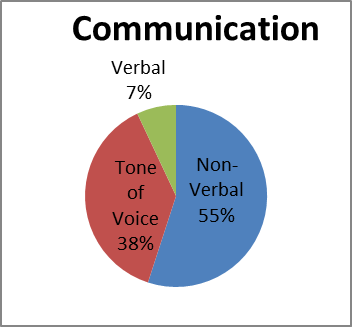Communication skills for Sales professional are very important as we communicate all the time either through words, silence or through actions.
The big barrier to selling is the communication barrier. The biggest communication barrier is the difference in the perception of the buyer and the salesperson.
If the salesperson has good persuasion skills then he can make the buyer perceive things his way.
Persuasion is defined as the ability to influence or change a person’s belief system and accordingly Deciding the Presentation Approach and Method
There are mainly two types of communication
a) Non-Verbal Communication
b) Verbal Communication
A professional should be aware of both verbal and non-verbal communication.
The salesperson should listen to words and feelings and observe if there is congruence or mismatch in the verbal and non-verbal communication.
Non-verbal for Communication skills for Sales professional:
Openness and acceptance can be communicated through positive body language.
Resistance and rejection can also be communicated with disagreeable body language.
Non-verbal communication comprises of posture, gestures, hand movements, eye contact and facial expressions.
Our non-verbal behavior or body language is driven by our subconscious, which reveals our thought process. For example:
·Eye contact :
Staring directly at your prospect could be taken as a sign of arrogance, aggression or rudeness.
Having shifty eyes can communicate uneasiness or cunningness.
Gazing at the ceiling or the fan shows a lack of interest or a non-caring attitude.
Comfortable ·eye contact establishes trust, builds confidence and reflects sincerity
·Posture:
Don't slouch or lean back can be interpreted as a lack of attentiveness or disinterest.
·Body movements:
Jerky movements show edginess and nervousness or even a lack of confidence.
·Gestures:
Yawning, playing with a ·pen or doodling, all indicate indifference.
·Facial expressions:
Stiff or uptight expressions or smiling sarcastically gives a negative impression.
·Overall grooming:
Professional appearance. You find professionals wear clothes that are not too trendy. They dress conservatively.
A Sales Professional would generally come in a formal suit or if it is too hot for the jacket, he would come in formal trousers, shirt and tie. He would not be dressed in jeans and sports shoes.
VERBAL for Communication skills for Sales professional:
When dealing with another person, one's tone should be pleasant and the pace of speech should be moderate - not too fast or not too slow and be careful of how you phrase your sentences.
Good sales professionals use words that are specific in order to ensure that they are transferring the same picture into the prospect's mind, resulting in clarity of communication.
Hence abstain from using vague words that have multiple meanings such as
Almost always
Occasionally
Regularly
Frequently
Sometimes, and
Seldom
All these words are non-committal, unspecific and raise doubt.
They create suspicion and hesitation in the mind of the buyer because the same words mean different things to different people, which becomes an obstacle in closing a sale.
Clarify vague statements that could have multiple meanings.
For example, it costs too much. This could mean many things, such as:
I don't have that much money.
This is not worth the price.
It is more expensive as compared to your competitors.
This one statement could mean anything. In order to be able to answer effectively, the salesperson needs to clarify by asking questions tactfully or through carefully worded sentences. For example:
'Is this your major concern?'
'What are your other concerns?'
'You just mentioned ...but somehow I get a feeling you seem to a little uncomfortable with...could I request you to share your thoughts/feelings with me...?'
Conclusion: for Communication skills for Sales professional:
A professional should be aware of both verbal and non-verbal communication.
Dr Albert Mehrabian did a study and came to the conclusion that fifty-five per cent of our Communication is nonverbal, thirty-eight per cent is the tone of voice and The one which we give the most importance to is only seven per cent and that is Verbal communication.
Whenever there is a contradiction between verbal and non-verbal, which one should we believe?
The answer is non-verbal because the non-verbal is a reflex action arising from the subconscious.
The communicator is not aware that it is happening. For instance, the communicator may be saying, I am very interested in what you are saying, 'but at the same time is looking at his watch, the ceiling fan or doing something else.
Is he really interested? What did you think non-verbal show interest and attentiveness in this case? Certainly not.
Be observant about body language. It will save you time and increase your chances of closing sales.
I also have a blog on Effective Techniques for objection Handling-Ultimate Guide-AGM.
About my blog on Communication Skills for sales Professional, If you have any suggestion please leave the comment below.


Took me time to read all the comments, but I really enjoyed the article. It proved to be Very helpful to me and I am sure to all the commenters here! It’s always nice when you can not only be informed, but also entertained! איך לבחור משרד יחסי ציבור
ReplyDelete